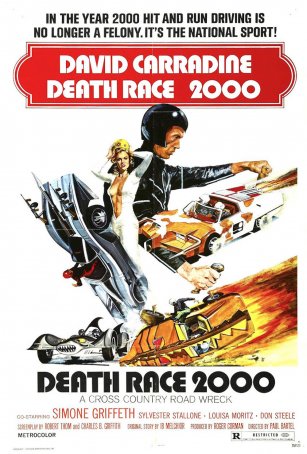

One of the things I really liked about “Death Race 2000” is its future setting, one where a Death Race is a sport and a place called New Los Angeles exists (makes you wonder what happened to the old one).Īnother thing I like about the movie is how cheap it is. The film also explains a bit about how the world is and what the situation in the year 2000 is (there’s actually backstory that can be looked up independently from the film itself). Pretty much anytime someone got killed was a laugh, due to the outrageousness of it all. This film made my cheeks sore due to the amount of laughter it gave me.

The one thing to keep in mind with this film is that it’s satirical so much of what you might see should not at all be taken seriously. There really isn’t much to this film, but any way to get it more exposure helps. All the while, a group of rebels is planning to stop the race indefinitely and put an end to the current regime that runs the country. Allan Arkush was brought in to conduct reshoots either because Niciphor quit or was fired on Carradine’s orders.Produced by the master of B-movies, Roger Corman, comes “Death Race 2000”, a 1975 satirical film starring David Carradine and featuring Sylvester Stallone before he was Rocky Balboa.īoth men play race car drivers, who, with their navigators, go across the former-US country and kill people with their cars in order to acquire points so that they can win the race (never mind actually getting first place in the actual race itself). Both Carradine and director Nicholas Niciphor have differing views about what occurred but both agree that Niciphor conflicted with Carradine and had a tyrannical manner, that Carradine assaulted Niciphor and that various of the crew, in particular Claudia Jennings (and possibly Carradine) were under the influence of drugs during shooting. Corman wanted it made in 21 days based around David Carradine’s availability. The film was apparently a mess behind the scenes.

The film clearly considered this would be enough in itself to maintain interest and this gives Deathsport extremely limited appeal beyond those that are motocross fans. Worse the middle of the film turns into a lot of buzzing around the desert on motorbikes. The same motorbike stunts and explosions are repeated several times. The film has a single matte painting of a futuristic city background for the arena and uses it several times over – and obviously so. Ultimately, it is this and the cheapness of the production that does Deathsport in. The Range Guides – with Deneer (Claudia Jennings) and Kaz Osay (David Carradine) on the left In actuality though, it is just David Carradine back in Kung Fu (1972-5) mode uttering imponderable epigrams – and here the prose really does become quite purple. While it uses the post-holocaust landscape instead of outer space as its playground, the film otherwise features the same type of story involving rayguns, heroes with mystical training, helmeted villains in black, and with motorcycle chases in lieu of interstellar dogfights.Ĭertainly, the idea of the mystical Range Guides gives the Mad Max copy a more intriguing and potentially substantial theme than usual. Of course, what Deathsport was trying to imitate at the time was Star Wars (1977). Without even realising it at the time, Deathsport prefigured Mad Max 2 (1981) and its trend-setting depiction of the post-holocaust landscape as a realm inhabited by motorised crazies and loner heroes engaged in gladiatorial combat. Although it wasn’t a Death Race sequel, this was a connection that Corman was more than happy to play upon in pre-release. In 1978, Roger Corman and David Carradine paired up again for Deathsport, which many took to be a sequel to Death Race 2000. This proved to be a surprising box-office success and later became the basis of Paul W.S. Producer Roger Corman and star David Carradine made Death Race 2000 (1975), a quirky attempt to capitalise on the success of the future sports theme of the larger-budgeted Rollerball (1975).


 0 kommentar(er)
0 kommentar(er)
